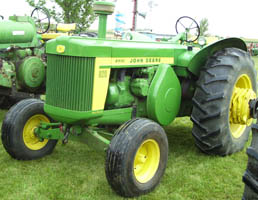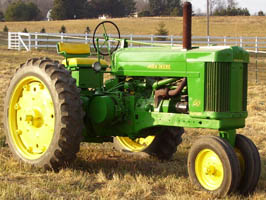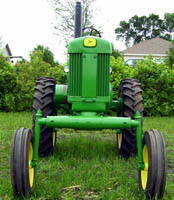Tractor Front Axle Types
Farm tractors have a variety of basic front-end configurations to accommodate different farming needs.
Standard
The standard front end is also known as a "regular" or "wheatland". It features an axle with a fixed distance between the front wheels. The standard front end was the first design used on early steam traction engines and gasoline tractors. These machines used a solid front axle that pivoted in the center, similar to a horse-drawn wagon.
While the standard front end has always been used on tractors, it became less popular during the middle of the twentieth century, when the tricycle design became popular. The standard front end remained the choice for the vast wheat farms of the western United States and Canada. This led to the standard being known as a "wheatland". Some manufacturers further distinguished a wheatland tractor with the use of wide fenders and a high operator platform.
 An adjustable wide front end is similar to the standard front end. The adjustable wide front allows the wheels to be moved to different widths to accomodate driving between rows of crops. By properly spacing the front and rear axles, the tractor will straddle several rows, enabling the operator to drive down them without damaging the crops. In addition to adjustments on the axle itself, some tractors allow the front wheel tread to be changed by reversing the mounting of the wheels, or through the use of spacer on the hub.
An adjustable wide front end is similar to the standard front end. The adjustable wide front allows the wheels to be moved to different widths to accomodate driving between rows of crops. By properly spacing the front and rear axles, the tractor will straddle several rows, enabling the operator to drive down them without damaging the crops. In addition to adjustments on the axle itself, some tractors allow the front wheel tread to be changed by reversing the mounting of the wheels, or through the use of spacer on the hub.
Standards have always been the style of choice for serious pulling tractors, the largest tractors in a manufacturer's range were seldom available as a row crop. Standards are also the default style for industrial tractors. The heavy front axle is well-suited to the demands of loader work.
 Tricycle
Tricycle
A tricycle (sometimes called "narrow") is a type of row-crop front end to enable the tractor to work between rows of planted crops, typically for cultivating. The tractor has either a single front wheel, or two front wheels that are narrowly set together. The front wheels are usually angled towards eachother in a 'V' shape so that both wheels fit between a crop row. The rear wheels are typically adjustable to accommodate a variety of row spacings.
The Farmall, introduced by International Harvester in 1924, pioneered this arrangement and quickly became one of the most successful tractors of all time. The tricycle front end became the dominant tractor design in the United States from the 1930s through the 1950s. In the 1960s, chemicals replaced mechanical tillage as the primary means of crop cultivation. With this development, the need for tricycle style tractors dropped sharply, and production of this style stopped in the 1970s.
In addition to the ability to move between rows of crops, the tricycle style of tractor also has excellent manuverability. With the use of individual rear-wheel brakes a tricycle tractor can pivot within its own length around one wheel. This tight turning radius is a great asset when working in confined areas or when mowing. The design is somewhat unstable when compared with wide-spaced front wheels, causing dangerous rollovers. The design is also difficult to use with a front-end loader, particularly when the tractor does not have power steering.
High Crop
 The high-crop tractor features tall spindles on the front axle, and drop-down rear axles, to provide it with a very high ground clearance. These tractors are very useful for farms growing vegetables, flowers, nursery plants, or any other tall and bushy crop that must be worked. Some manufacturers referred to their high crop tractors as "vegetable" models.
The high-crop tractor features tall spindles on the front axle, and drop-down rear axles, to provide it with a very high ground clearance. These tractors are very useful for farms growing vegetables, flowers, nursery plants, or any other tall and bushy crop that must be worked. Some manufacturers referred to their high crop tractors as "vegetable" models.
High crop tractors have always been rare when compared with more conventional designs. For antique tractor collectors, high crop models often command very high prices due to their low production volume.
©2000-2026 - TractorData.com®. Notice: Every attempt is made to ensure the data listed is accurate. However, differences between sources, incomplete listings, errors, and data entry mistakes do occur. Consult official literature from the manufacturer before attempting any service or repair.